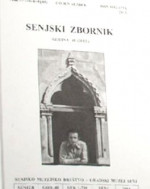Tri inkunabule iz Senja u knjižnici franjevačkog samostana Trsat. Prilog povijesti franjevaca u Senju
Three incunabula from Senj in the library of the Franciscan monastery of Trsat. Contribution to the history of Franciscans in Senj
Author(s): Fila Bekavac Lokmer, Juraj LokmerSubject(s): Croatian Literature, 13th to 14th Centuries, 16th Century, Pastoral Theology
Published by: Senjsko muzejsko društvo i Gradski muzej Senj
Summary/Abstract: The Franciscans who were welcomed in Senj in the mid-13th century abandoned it in 1807 because their monastery in the centre of the city was intended for the diocese seminary by the Hungarian government and which in 1806 was opened by the Senj-Modruš bishop Ivan Krstitelj Ježić. With it was taken the monastery’s archive and library which is today an integral part of the library of the Franciscan monastery of Trsat. The Croatian Franciscan Province of St. Cyril and Methodius from 2011 has been systematically processing the material of its rich library with the application of modern information and communication technologies and methods. Thus in the library of the Trsat monastery the oldest material of the collection is being dealt with first: the incunabula and foreign books of the 16th century. Amongst the incunabula are also located three incunabula which, as can be seen from their markings, once belonged to the Franciscan monastery in Senj and which came from Senj. The first incunabulum which was owned by Senj’s Franciscans is: Confessionale: Defecerunt scrutantes scrutinio. Add: Titulos de restitutionibus or IncipitSummula confessionis utilissima ..... It was a handbook for confessors, as well as for penitent women, which was written by Antoninus Florentinus, a Dominican and archbishop of Florence. Printed in 1473 in Venice in the print workshop of Bartholomeusa Cremonensis. In that incunabulum is written by hand ex libris: Conventus Segnensis. In the second incunabulum is Summa angelica de casibus conscientiae (cum add. Hieronymi Tornieli), a work written by Angelum de Clauasio (Angelum de Clauasio), and an epistle – a letter in the preface of Girolamo Tornielli. It was printed in 1486 in the village of Chiavasso in the print workshop of Jacobinusa de Suigo de sancto Germano. For this book, which also deals with the problem of confession, sin and examination of the conscience, it cannot be said that it belonged to the Senj Franciscan monastery, but from the notes from 1659 it is known that it was in Senj and that it was owned byStjepan Pribinović, who had handed it to a friar L.V. The third incunabulum is one from an edition of a collection of papal decretals: Noua decretalium compilatio Gregorii IX. ... feliciter explicit or under the general title Decretales cum glossa, which was composed by an order of Pope Gregory 9th, by his chaplain and legal expert Raymond of Peñaforte (Pennafort), and the author of the comments of this publication Bernard from Botone or Parmensis, professor of the University of Bologna. The book was printed by Thomas de Blavis in Venice in 1489. This book has marks in two places which show its affiliation with the Franciscan monastery and the year 1804. These books are a part of the great literary wealth of Croatian cultural heritage but they also testify to the centuries of theological, ecclesiastical, cultural and legal traditions of the Franciscan community, the Franciscan monastery in Senj and in Trsat. They are precious monuments to the faith, culture and scientific traditions of the town of Senj and Croatia, the country’s rich European, Christian culture and civilisation.
Journal: Senjski zbornik - prilozi za geografiju, etnologiju, gospodarstvo, povijest i kulturu
- Issue Year: 40/2013
- Issue No: 1
- Page Range: 363-396
- Page Count: 34
- Language: Croatian

